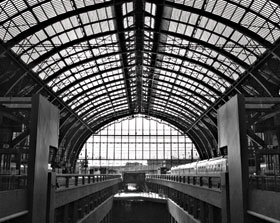

On the railways, incidents are a daily occurrence and how they are managed has a huge impact on the network operator, train companies, emergency services, staff and of course, passengers. By improving how incidents are handled you can meet your primary objective of ensuring the safety and security of all, but also make a huge contribution to minimising delays and disruption to the timetable, as well as the cost implications or compensation and stiff penalties if the railway does not hit its operational targets.
Regardless as to whether it is a minor delay to a passenger train, or an act of terrorism, every incident can be divided in to a lifecycle of three distinct phases – preparation, management and investigation. How successful an incident is handled rests on the quality of the preparation that has been put in place, the speed at which the incident is detected and the ability of those responsible to carry out their duties as quickly and effectively as possible, to prevent unnecessary escalation. Finally, you need to be able to review the incident and learn from it, in order to mitigate the risk of it repeating.
Fortunately, serious incidents on the railways are infrequent, but when they do happen, the impact is immediate and intense, with huge media attention and scrutiny. However, rail companies are also painfully aware of the cumulative impact of minor incidents, which can cost many millions annually.

Integrated solutions essential
As a result, rail operators have invested heavily in a plethora of safety and security systems such as CCTV upgrades (analogue to IP, as well as a significant increase in the overall number of cameras), advanced video analytics, access control systems, smoke detectors, fire alarms, perimeter alarms, audio communications, help-points, customer information and public address systems etc.
The challenge with increasing the number of systems is how the people responsible for monitoring them make sense of the mass of data that is being pushed at them, without suffering from information overload. And, when they are alerted to an incident how do they use all of the tools and systems at their disposal to manage it, in accordance with best practice?
Situational awareness, or PSIM (Physical Security Information Management), is an approach that many rail operators are using to make the whole process simpler, by taking this big data and transforming it into operational intelligence. Aeroexpress in Moscow, ProRail in the Netherlands and King’s Cross station in London have all recently announced implementations of PSIM solutions at their operational control centres, to take these siloed gateways, collate them and deliver the operator in the control room with a single, clear, real-time operating picture.
How the system works
An alarm is received in the control room, where an operator is at his station with three large screens in front of him. The alarm comes from a camera in an area defined as restricted for access, registering motion where people are not supposed to be walking freely.
On the left screen, he sees what’s happening, with video streamed directly from the relevant camera. The video analytics application has identified that it’s a person and then zoomed in to provide a closer look. Meanwhile, the right screen is displaying a GIS map, so he can see exactly where the incident is happening.
The operator uses the middle screen as his nerve centre. All of the feeds from all of the systems and sub-systems are being unified to give him a total awareness of what is going on and where. What is more, as the incident unfolds the operator is given clear and concise instructions directing him what to do and when, in accordance with best practice (pre-defined by the rail operator using adaptive workflows). The system further supports the operator by automatically completing actions as certain triggers are reached.
A PSIM solution comes in to its own when security and maintenance teams on the ground and the third-party stakeholders such as train operators, transport police and other emergency services need to be involved. Then the operator is able to share in real-time vital information and co-ordinate the response all from his chair. For example, if there is a fire on a freight train the operator can review the manifest and details of the cargo being transported (e.g. whether it is hazardous) to the fire crew en-route, so they are fully aware and ready to take the necessary action as soon as they arrive.
A PSIM solution not only captures all of the data feeds from all of the systems, it also stores all of the actions that are being taken. So, whether immediately after the event or days, weeks or even years later, the entire incident can be reconstructed, synchronised and replayed in chronological order, whether for training, as part of a continuous cycle of improvement, or for evidence submission.
Efficiency through better data use
By shortening the lifecycle, incidents are handled faster and investigations can be carried out quicker and in far more detail. Lessons learnt can be fed back in to the system within hours, so if a similar incident occurs the operator will be hand-held through a new improved workflow.
In the case of ProRail, the organisation is using its PSIM solution to facilitate the effective management of 45 000 incidents a year, of which 45 are crisis incidents on the Dutch rail network.
At the heart of PSIM is an understanding that in high pressure situations people are excellent at making the right judgements and decisions based on the information they are presented with. PSIM takes very complex technology systems and presents only the valuable information to the operator in a way that enables them to use their skills. However, as we are all prone to making mistakes, or taking the occasional short cut, the workflows also provide a vital fail-safe. So, whether you have been working in the control room for two weeks or twenty years, the quality of incident handling will be consistently high.
Reducing the probability of an incident happening and lessening the impact of those that will inevitably occur, not only creates a safer and more secure environment for all on the rail network, it also means that the saving made can be redeployed for investment in other areas of the organisation. When we talk about security it is rightly argued that you cannot put a price on a life, however PSIM provides a compelling proposition whereby you can greatly improve safety and save substantial costs at the same time.
For more information contact NICE Systems, +44 1489 771 200, emea@nice.com, www.nice.com

© Technews Publishing (Pty) Ltd. | All Rights Reserved.